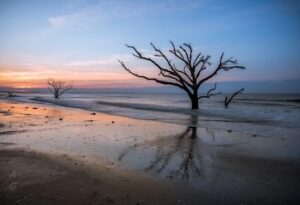
Edisto Island
*Edisto Island is affirmed on this date in 1600. This area is one of South Carolina's Sea Islands, the larger part of which lies in Charleston County. The historic Edisto people are known to have occupied the Island as well as mainland areas and traded with the upcountry Catawba during the Middle Passage.
Indigenous peoples often had fishing camps on the islands, using them seasonally. The first tracts of land, known as plantations, were granted on Edisto Island before 1700. There were several attempts by the French and Spanish to settle in this area in the 1500s; however, all of these attempts ultimately failed. The first group of Europeans to settle Edisto Island was the English, who arrived in the late 1600s and early 1700s. Although it is unclear when the modern name was adopted, the Island was called "Locke Island" after the English philosopher and Secretary to the Lords Proprietors of Carolina, John Locke, during the late 1600s.
For most of the 1700s, the area exported rice. Landowners first harvested timber and deerskins, planted indigo and some rice, and kept herds of free-ranging cattle to produce hides for the European market and salt beef for Caribbean plantations. Cotton gradually became the principal crop, and after the American Revolution, Edisto Island planters became wealthy and famous from their production of long-staple Sea Island cotton. The labor was done by hundreds of enslaved Africans who developed the creole Gullah language and culture on the islands and in the Lowcountry, which is distinctive for its African traditions.
During the American Revolution, numerous British soldiers were stationed on Edisto Island. After retaking Savannah in 1778, the British pushed into South Carolina, and during this time, Beaufort was designated as their headquarters. Hence, a significant number of British troops were stationed on Edisto Island after the capture of Charleston in 1780. The 1790 census reported the Island had a population of 223 whites and 1,692 Black slaves. The 1860 census indicated 329 Whites and 5,082 slaves.
During the American Civil War, Edisto Island was abandoned mainly by planters in November and December 1861, and escaped slaves began setting up their refugee camps there. In January 1862, armed settlers from the Island and Confederate forces clashed, and a Confederate raid in reprisal killed unarmed colonists. In February, Union forces were stationed on the Island to develop it as a staging area for future campaigns against Charleston, twenty-five miles away, as well as to protect the colony, which would eventually number thousands of settlers.
As Union forces took control of the Island, several skirmishes occurred, and Confederates withdrew. Pineberry Battery was further up the Edisto River from the Island, which was one likely path for a land campaign against Charleston. In June, most of the Union troops left the Island in a campaign, which culminated in the Battle of Secessionville. In July, the remaining forces withdrew, and the colony was removed to St. Helena Island. For the rest of the war, a small number of escaped slaves and plantation owners remained and farmed the Island, but it was largely abandoned. Near the end of the war, the Island was again used as a location for colonies of freed slaves.
From 1865 to 1877, the Island was primarily run by agents of the Freedmen's Bureau, as well as by recently freed African Americans. As a result, the Island became a base of support for the Republican Party. While Klan terror affected much of the state, Edisto Island was spared mainly by coincidence. There were troops from the United States Army present on Edisto Island, and the population was overwhelmingly Black. Most whites on the Island were either troops from the United States Army or agents of the Freedmen's Bureau. As a result, the Klan deemed the area not worth it and focused their activities elsewhere in the state. Since the twentieth century, the Island has been redeveloped for use as a tourist destination and resorts, although some private plantations remain.
Edisto Island is located 26 miles (42 km) southwest of Charleston. Edisto Beach State Park is also located on the Island. The park is open to day visitors as well as those camping in tents and RVs. The park has a ranger station, bathrooms with running water and showers, a playground, and an education center. The campsites are unique in that many are situated on the beachfront, offering an unobstructed view of the ocean. Hanging moss trees shade the park. Each site is equipped with electricity and water hookups, a fire pit, and a picnic table. Edisto Beach is in Colleton County, and the Charleston County part of the Island is unincorporated.